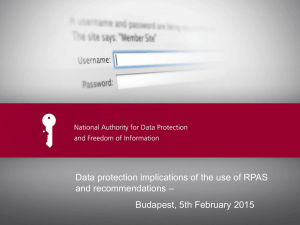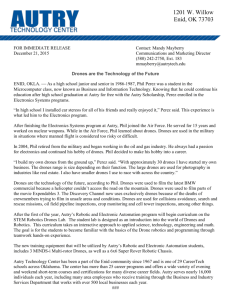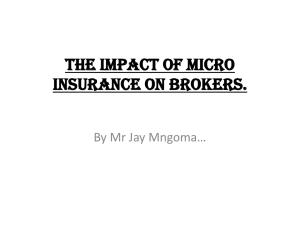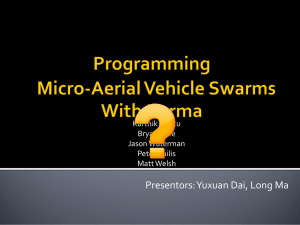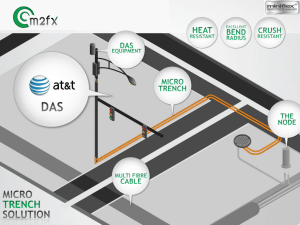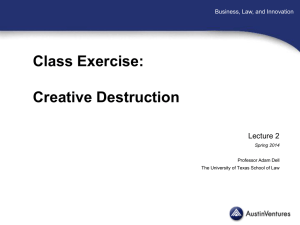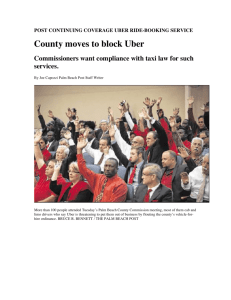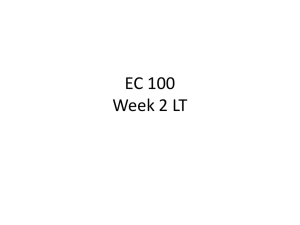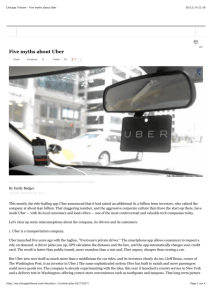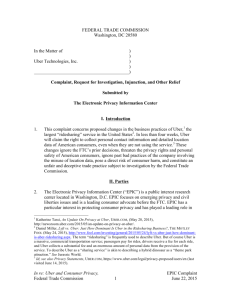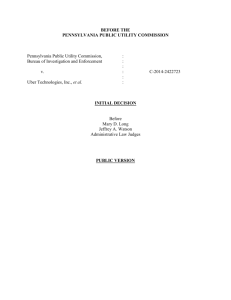Google, and Uber, and Drones (Oh, My!): A Less-is
advertisement
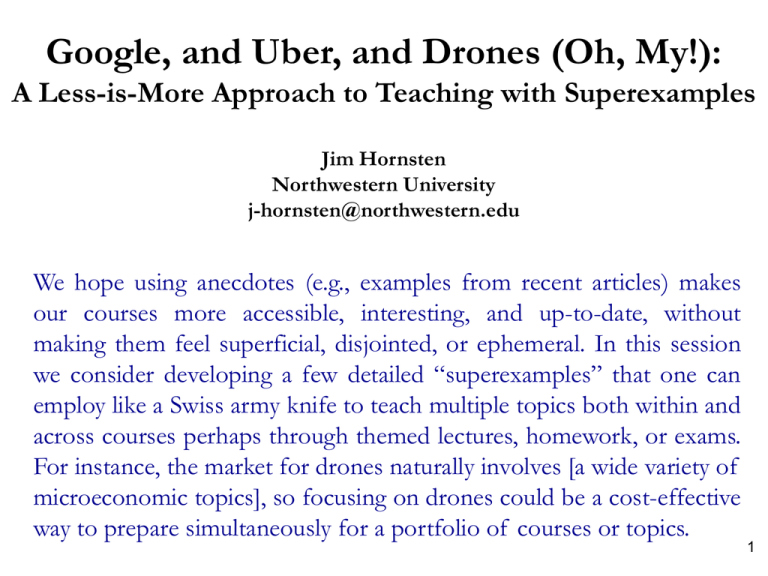
Google, and Uber, and Drones (Oh, My!):
A Less-is-More Approach to Teaching with Superexamples
Jim Hornsten
Northwestern University
j-hornsten@northwestern.edu
We hope using anecdotes (e.g., examples from recent articles) makes
our courses more accessible, interesting, and up-to-date, without
making them feel superficial, disjointed, or ephemeral. In this session
we consider developing a few detailed “superexamples” that one can
employ like a Swiss army knife to teach multiple topics both within and
across courses perhaps through themed lectures, homework, or exams.
For instance, the market for drones naturally involves [a wide variety of
microeconomic topics], so focusing on drones could be a cost-effective
way to prepare simultaneously for a portfolio of courses or topics.
1
Google, and Uber, and Drones (Oh, My!):
A Less-is-More Approach to Teaching with Superexamples
•
•
•
•
Why Do We Teach Using Examples?
What’s the Ideal # of Examples?
The Educational Input Mix
One Idea for Many Topics
• Mapping to Mankiw’s Micro Principles
• Themed Homework or Exams
• Superexamples
• Google
• Uber
• Drones
• One Idea for Several Courses
• Workshop: What Other Topics Might Work?2
Why are we here?
(At a national economics teaching conference)
• Thinking about an educational production function!
• How can I better attain my teaching objectives?
• My motivations could be
Improve student results (e.g., understanding, retention, fun, TUCE scores)
Improve teaching results
Have more fun
Cut prep time/costs
Inject novelty & variety into familiar material
Establish credibility
Build rapport
Challenge self to learn a new “technology”
"Output"=f["Inputs"]
=f[flip classroom, use clickers, create Facebook page, run experiment, magic tricks,
tinker with grading scheme, assign group project, employ think-pair-share,
teach with Seinfeld or Harry Potter or clowns theme, adopt Socratic method, etc.]
3
4 Ways of Communicating Most ECON Ideas
• Intuition
Explain it to your roommate, parent, or stranger at a party
• Anecdotes (Examples)
The singular of data is anecdote – G. Stigler
Find it in The Economist, NY Times, WSJ, Wired, Cosmo, Sports Illustrated
• Math (Theory)
Plug numbers into a formula; find a first-order condition
• Graphs (Theory)
Find peak of a hill-shaped profit function
• GOAL: Teach students to fluently translate between these forms, as
if they were translating Thank you into other languages [Gracias,
Merci, Danke, Grazie, Arigato, Diakuju]
• 4-D hard to draw; let’s simplify to Theory & Examples
4
Teaching With Examples: Why Do This?
• This is a weak list … What am I missing?
• PROS
Accessible
Interesting
Up-to-date
Fun to do online searches to “prep for class”
• CONS
Superficial
Disjointed
Ephemeral
Costly to do each term
There are a lot of examples out there
competing for our attention, so how
do we narrow them down?
5
How Many Examples to Employ?
A Spectrum of Possibilities
N = # of Examples
N=0
N small
Probably Too Few; Unclear if
ECON Applies to Real World;
Maybe Professor Doesn’t Really
Know This Topic
N large
Goldilocks
Level in a
Laffer
Curvian
Way
N
Probably Too Many;
Redundant or Overwhelming;
No Time Left to Cover Theory
It’s probably not a bad idea to think about this occasionally,
especially when preparing a new lecture or course
6
IsoQuants: QWidgets = f[Labor, Capital]
min TC[L, K ] = wL + rK subject to Q Target = f [L, K ]
L,K
Capital,
K
(Robots)
where L=labor, K=capital,
w=wage, r=rental rate, and
Q Target = output target
Perfect Complements: Q = min {L, K}
Imperfect Substitutes: Q = LK
Perfect Substitutes: Q = L + K
Labor,
L
(Humans)
A benchmark model from micro theory
7
IsoQuants: QEducation = f[Examples, Theory]
Let’s replace (L,K) with (E,T) and
widgets with educational outputs
Theory,
T
(Graphs
& Math)
Perfect Complements: Q = min {E, T}
Imperfect Substitutes: Q = ET
Perfect Substitutes: Q = E + T
Examples,
E
(anecdotes
& articles)
8
E.T. The Extra-Terrestrial (1982, Universal/Amblin)
ASIDE: From the Students’ Perspective,
IsoUtility: UEducation = f[Examples, Theory]
Theory,
T
(Graphs
& Math)
Prefer a Heavy Dose of E: U = E0.8 T0.2
Bliss Point: U = 100 – (E – 3)2 – (T – 3)2
Theory is Bad: U = E – T
Examples,
E
(anecdotes
& articles)
How do our students feel about our
mix of theory and examples?
9
SUPEREXAMPLES: A Way to Kill 2 (or more!)
Topical Birds with 1 Course Prepping Stone
• Sometimes we want to show how ECON fits together in a cohesive
way. It’s not just a collection of anecdotes. (Cf. behavioral )
End of Unit Review
Wrap Up Course
• Why do we typically teach micro principles around the model of
perfect competition … and then venture off into monopoly,
oligopoly, externalities, public goods, moral hazard, adverse
selection, transactions costs? Nice to set up benchmark, and then
do comparative statics.
• “The View From 30,000 Feet”
10
Table of Contents for Greg Mankiw’s
Microeconomics
1. Ten Principles
2.
3.
4.
5.
6.
7.
8.
9.
10.
11.
Thinking Like Economists
Gains From Trade
Mkt Forces of S&D
Elasticity
Govt Policies and S&D
Mkt Efficiency
Taxation
International Trade
Externalities
Public Goods & Commons
12.
13.
14.
15.
16.
17.
18.
19.
20.
21.
22.
Tax Systems
Production Costs
Competitive Firms
Monopoly
Monopolistic Competition
Oligopoly
Factor Markets
Discrimination
Income Inequality
Consumer Choice
Micro Frontiers
Challenge: Pick a topic, and try to
link it wo each of these chapters
11
Application: Themed Exams
• In Micro Principles I’ve used smartphones, beef, summer,
umbrellas, tofu and space
• PROS:
Easy to keep track of – when students come to office hours it’s a lot easier to
refer to the chicken soup exam than Practice Exam #1, the Fall 2014
Midterm Exam, or F14ME
Can be fun if students wonder what the theme will be
• CONS:
May seem strained (desperate)
Adds constraints, making it a bit tougher to write exam
Makes the exam a bit longer as you add words to place into context
12
E.g., Pharmaceutical Patent-Themed Homework
13
E.g., A Space-Themed Micro Principles Exam
• GOAL: Cover Unit 1 Material with Common Theme
• TASK: Find space-y topics to test S&D shifters, etc.
S&D shifters in the mkt for wool blankets, used by stargazers. [Weak]
Cross price elasticity of demand using Pfleece and Qwool
Minimum wage & occupational licensing in futuristic, competitive labor mkt
for Vomit Comet pilots (weightlessness from flying in parabolic arcs)
Public Good: Near-Earth Object Program to track comets & asteroids
Externalities: City Lights reduce crime, but obscure meteor shower viewing
Gravity as an artificially scarce good; P>MC creates DWL
Subsidizing Armageddon-style space heroes
SpaceX CEO Elon Musk’s income taxes
14
Links to Microeconomic Topics
1.
2.
3.
4.
5.
6.
7.
8.
New Year’s Eve demand for rides; WTP more?
Uber drivers use own cars; costly to supply rides
Equilibrium price may be high; surge (peak-load) pricing
Voluntary, mutually beneficial trades
PED: Do many ppl switch from traditional cabs to Uber b/c Plow
Taxicab medallions & occupational licensing: govt policies
Welfare analysis: CS = WTP – Ppaid, DWL from scarce cabs
ASIDE: An interesting topic; current freshlings enamored by
sharing economy possibilities (rent/share rather than own; live at
home and pay off college loans)
15
UBER: Link to Sharing Economy
16
Links to Microeconomic Topics
1.
2.
3.
4.
5.
6.
7.
8.
9.
Antitrust troubles in Europe
Online search
Big player in M&A; often averages one acquisition per week
Hardware:
OS: Android
Patents: Motorola
High Tech Gadgets: Google Glass, driverless car
Censorship
Prioritized search results
17
Who’ll Win?
18
Links to Microeconomic Topics
1.
2.
3.
4.
5.
Military spending
Privacy & noise externalities
Cool, new 3-D selfies
Shd FAA keep them away from airports?
Shd another regulator keep them from spying on me?
• The market for drones naturally involves civil aviation regulation,
airspace property rights, privacy and noise externalities, public
goods (Samuelson’s rule, taxes, voting, bureaucracy), delivering
goods to soldiers or Amazon customers way off the beaten path,
and defense contract bidding, so focusing on drones could be a
cost-effective way to prepare simultaneously for a portfolio or
courses or topics.
19
DRONES: Link to Automation: Replacing L with K
When does it make economic
sense to use/send a machine
instead of a (wo)man?
20
SUPEREXAMPLES: A Way to Kill 2 (or more!)
Course Prepping Birds with 1 Topical Research Stone
• Assumptions:
In your educational production function, perhaps theories and examples are
perfect complements
E.g., Q = min {T, E}, so you need one good example to clarify each theory
You have an endowment of theory inputs (i.e., you don’t need to prep the
theory part of your lecture)
Examples get stale/dated/unfamiliar/unproductive, so you regularly need to
buy new examples. Sorry, that’s life.
It takes X hours to develop one new example
Each lecture requires one example
You teach three different courses
• Goal: Spend less than 3X. Indeed, try to spend only X.
• Idea: Cut prep time by spreading fixed costs across courses.
• How? Find examples that work in multiple courses
21
Case: 3 Courses on Regulation, 1 Common Topic
• ECON 101: Freshling Writing Seminar on “Economics of Regulation”
Licensing cosmetologists, seatbelts & Peltzman Effect, recalling Buckyball
magnets, texting while driving PSAs, online privacy & targeted ads, soda taxes to
fight obesity, raw milk cheese bans, Too Big To Fail banks, soaring student debt,
FDA & e-cigarettes, Facebook’s network effects, adverse selection & ACA, lowflow water fixtures, how to slow climate change
• ECON 250: Business and Government (for non-majors)
Apply micro principles to study the proper role of government in the economy
• ECON 350: Monopoly, Competition & Public Policy (Jr/Sr majors)
Apply micro theory to study monopolization in the context of public utilities,
intellectual property, cartels, predation, horizontal mergers, and network effects
Should we discourage patent
assertion entities (“trolls”)?
22
Google, and Uber, and Drones (Oh, My!)
What are some other current topics
(markets, firms, products) that would
allow you/me to exploit these
efficiencies in course preparation?
23
The Wizard of Oz (1939, MGM)


